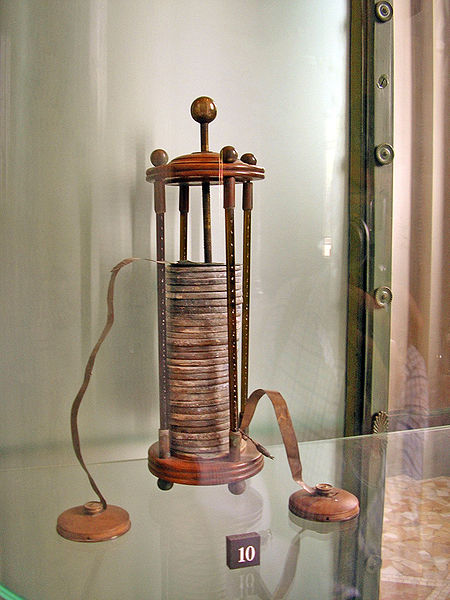The voltaic pile was the first electrical battery that could continuously provide an electric current to a circuit. It was invented by Italian chemist Alessandro Volta, who published his experiments in 1799. Its invention can be traced back to an argument between Volta and Luigi Galvani, Volta's fellow Italian scientist who had conducted experiments on frogs' legs. Use of the voltaic pile enabled a rapid series of other discoveries, including the electrical decomposition (electrolysis) of water into oxygen and hydrogen by William Nicholson and Anthony Carlisle (1800), and the discovery or isolation of the chemical elements sodium (1807), potassium (1807), calcium (1808), boron (1808), barium (1808), strontium (1808), and magnesium (1808) by Humphry Davy.
A voltaic pile on display in the Tempio Voltiano (the Volta Temple) near Volta's home in Como, Italy
Voltaic pile, University History Museum of the University of Pavia.
Drawing of the voltaic pile in different configurations, from the letter sent from Alessandro Volta to Joseph Banks.
An electric battery is a source of electric power consisting of one or more electrochemical cells with external connections for powering electrical devices. When a battery is supplying power, its positive terminal is the cathode and its negative terminal is the anode. The terminal marked negative is the source of electrons that will flow through an external electric circuit to the positive terminal. When a battery is connected to an external electric load, a redox reaction converts high-energy reactants to lower-energy products, and the free-energy difference is delivered to the external circuit as electrical energy. Historically the term "battery" specifically referred to a device composed of multiple cells; however, the usage has evolved to include devices composed of a single cell.
Various cells and batteries (top left to bottom right): two AA, one D, one handheld ham radio battery, two 9-volt (PP3), two AAA, one C, one camcorder battery, one cordless phone battery
A voltaic pile, the first battery
Italian physicist Alessandro Volta demonstrating his pile to French emperor Napoleon Bonaparte
From top to bottom: a large 4.5-volt 3R12 battery, a D Cell, a C cell, an AA cell, an AAA cell, an AAAA cell, an A23 battery, a 9-volt PP3 battery, and a pair of button cells (CR2032 and LR44)







